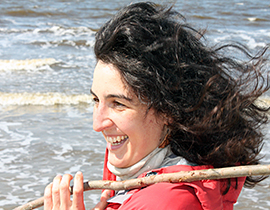Katrien Heirman

As a child Katrien was fascinated by explorers like Sir Henry Morton Stanley or Roald Amundsen, people who had filled in the ‘white’ spots on the map. Becoming and being an Earth scientist gives her the chance to do what Stanley and Amundsen did: explore.
During her PhD, Katrien studied the evolution of climate in the Southern Hemisphere using lake sediments mainly focussing on the Kerguelen Archipelago, East Antarctica and southern Chile. Since geological records are almost always an amalgam of many different environmental signals, especially in a dynamic region as Chile, she had the luck of collaborating in several interesting research projects related to geohazards (earthquakes, volcanic eruptions, …).
Multidisciplinarity kept on being and still is an important part of her research interests. She had the opportunity to join the NanTroSEIZE IODP expedition in Japan studying earthquakes, accretionary prims and plate boundaries and the geoarchaeological Arch Manche project in which archaeologists, Earth scientists and (art) historians studied the interactions between mankind and geology during the Holocene and Antropocene in the southern North Sea region.
The link between geology and community has always been an important aspect in Katrien’s career as a scientist thanks to several outreach projects and the opportunity to work at the UNESCO Earth Science Unit and the International Geoscience Programme (IGCP).
Within GLANAM Katrien is based at the Geological Survey of Denmark and Greenland (GEUS). Her main objective within this project is to study the seismic architecture of the South East Greenland margin.
GLANAM Output
LATEST NEWS
GLANAM NEWSLETTERS
- GLANAM Newsletter 13 – October 2016
- GLANAM Newsletter 12 – August 2016
- GLANAM Newsletter 11 – June 2016
- GLANAM Newsletter 10 – April 2016
- GLANAM Newsletter 9 – February 2016
- GLANAM Newsletter 8 – December 2015
- GLANAM Newsletter 7 – October 2015
- GLANAM Newsletter 6 – August 2015
- GLANAM Newsletter 5 – June 2015
- GLANAM Newsletter 4 – April 2015
- GLANAM Newsletter 3 – February 2015
- GLANAM Newsletter 2 – April 2014
- GLANAM Newsletter 1 – November 2013
